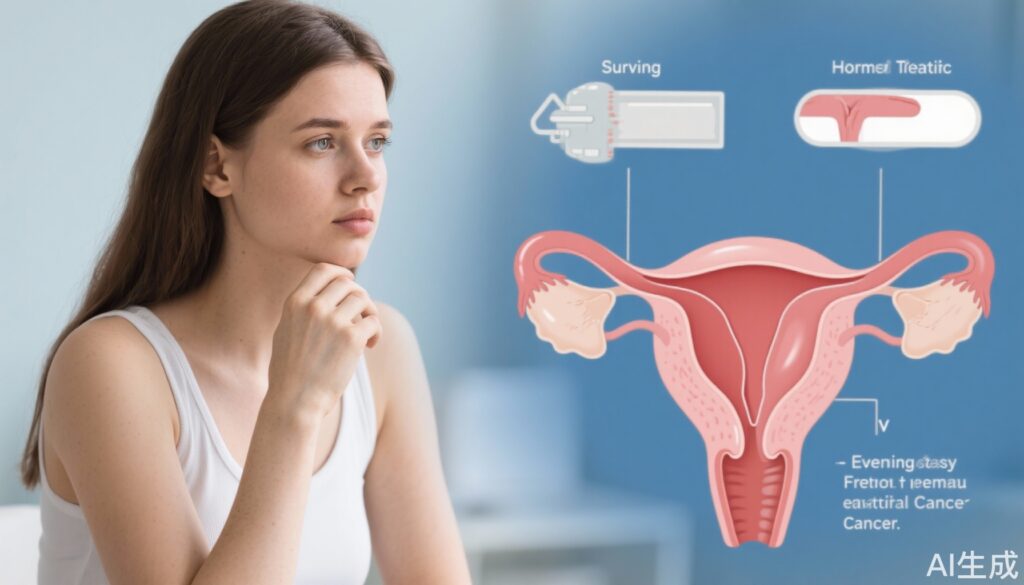Highlight
1. The use of fertility-preserving hormonal therapy for early-stage endometrial cancer among women aged 18-49 years increased significantly from 2004 to 2020.
2. Overall 5-year survival is slightly lower for hormonal therapy compared to hysterectomy, with a hazard ratio of 1.84 favoring hysterectomy.
3. In patients younger than 40 years, survival is comparable between the two treatments.
4. Patients aged 40-49 years treated with hormonal therapy exhibit a notably higher risk of death than those undergoing hysterectomy.
Study Background and Disease Burden
Endometrial cancer is the most common gynecologic malignancy in developed countries, with incidence rising, particularly among younger women. Early-stage endometrioid carcinoma generally carries a favorable prognosis, and standard treatment involves hysterectomy, which precludes future fertility. However, with increasing numbers of reproductive-aged women diagnosed with early-stage disease, there is growing interest in fertility-sparing approaches, notably progesterone-based hormonal therapy, to preserve reproductive potential.
The clinical challenge lies in balancing oncologic safety with fertility preservation. Limited prospective data exist on the long-term survival outcomes comparing fertility-preserving hormonal therapy with hysterectomy in young women, necessitating robust population-level studies to guide decision-making.
Study Design
This retrospective cohort study utilized the National Cancer Database, capturing data from female patients aged 18 to 49 years diagnosed with clinical stage I, grade 1 to 2, endometrioid endometrial cancer between 2004 and 2020. Patients who underwent either primary hysterectomy or fertility-preserving hormonal therapy were identified.
Primary exposures were defined by the first treatment received after diagnosis, within a specified timeframe — either hysterectomy or progesterone-based hormonal therapy. Propensity score matching was employed to balance baseline clinical characteristics between groups to reduce confounding.
The primary outcome was all-cause mortality measured at 2, 5, and 10 years post-diagnosis. Survival analyses were stratified by age (<40 and 40-49 years) given differential reproductive considerations and possibly biological differences in tumor behavior.
Key Findings
The cohort included 15,849 women: 14,662 (92.5%) underwent primary hysterectomy (mean age 44 years) and 1,187 (7.5%) received primary hormonal therapy (mean age 34 years). Notably, the use of fertility-preserving hormonal therapy rose from 5.2% in 2004 to 13.8% in 2020, reflecting increasing clinical adoption.
After propensity score matching to control for confounders, 5-year survival was 98.5% in the hysterectomy group versus 96.8% in the hormonal therapy group. The hazard ratio for mortality comparing hormonal therapy to hysterectomy was 1.84 (95% CI, 1.06-3.21), indicating a statistically significant but modestly increased risk of death with hormonal therapy overall.
When stratified by age, there was no survival difference in women under 40 years (HR 1.00, 95% CI 0.50-2.00), suggesting hormonal therapy confers similar long-term survival as hysterectomy in this subgroup.
Conversely, in women aged 40 to 49 years, hormonal therapy was associated with a significantly increased risk of death (HR 4.94; 95% CI, 1.89-12.91), highlighting a potential age-related differential effect.
These findings underscore the nuanced balance between fertility preservation and oncologic safety. The safety of hormonal therapy appears acceptable in younger women but warrants caution and thorough counseling in older reproductive-aged women.
Expert Commentary
These results provide critical population-level evidence supporting the use of fertility-preserving hormonal therapy as a feasible option in women under 40 with low-grade, early-stage endometrioid endometrial cancer, consistent with NCCN and ESGO guidelines recommending conservative management in carefully selected patients.
However, the heightened mortality risk noted in women aged 40-49 years underscores the heterogeneity of this population. Possible biologic explanations include more aggressive tumor behavior or host factors that reduce response to hormonal therapy.
Limitations include the retrospective design, potential residual confounding, and lack of detailed data on treatment adherence or specific hormonal regimens. Additionally, fertility outcomes and quality of life metrics were not assessed, which are important patient-centered endpoints.
Future prospective studies focusing on molecular classification, optimal hormonal protocols, and integration of assisted reproductive technologies may enhance individualized care for these patients.
Conclusion
The increasing adoption of fertility-preserving hormonal therapy reflects evolving patient and clinician preferences toward fertility retention in early-stage endometrial cancer. While overall survival is marginally lower with hormonal therapy compared to hysterectomy, the oncologic safety of such an approach in women younger than 40 years appears comparable, offering a viable fertility-sparing strategy.
Clinicians should engage in shared decision-making, incorporating age, tumor characteristics, and patient wishes when considering fertility-preserving options. Hormonal therapy in women aged 40-49 years requires cautious selection and close surveillance due to the observed increased mortality risk.
Continued research and multidisciplinary care are essential to optimize outcomes in this growing patient population.
References
- Suzuki Y, Huang Y, Xu X, Ferris JS, Elkin EB, Kong CY, Myers ER, Saji H, Miyagi E, Havrilesky LJ, Blank SV, Hershman DL, Wright JD. Survival After Fertility-Preserving Hormonal Therapy vs Hysterectomy for Early-Stage Endometrial Cancer. JAMA Oncol. 2025 Aug 28:e252761. doi: 10.1001/jamaoncol.2025.2761. Epub ahead of print. PMID: 40875243; PMCID: PMC12395355.
- NCCN Clinical Practice Guidelines in Oncology: Uterine Neoplasms. Version 1.2025.
- Rodolakis A, et al. Fertility Preservation in Endometrial Cancer and Atypical Hyperplasia: A Review of Current Evidence and Future Perspectives. Eur J Obstet Gynecol Reprod Biol. 2022;268:26-34.



